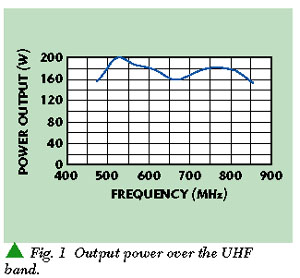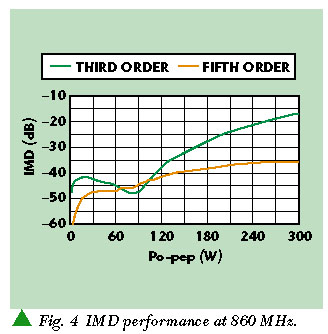A High Power LDMOS Transistor for Broadcast Transmitter Applications
Philips Semiconductors
Eindhoven, The Netherlands
Digitization in the broadcast world is paving the way for major new markets, such as high speed Internet access and mobile multimedia in-car entertainment, as well as high definition TV and a huge expansion in program choice. With standards now in place, as well as an increasing number of commercial services and rapidly maturing technology, broadcasters and service providers are keen to push forward the move to digital transmission. A unique ultra-high frequency (UHF) power lateral double-diffused metal-oxide semiconductor (LDMOS) transistor has been developed that cuts the cost of upgrading terrestrial transmitters for digital operation.
Digital technology enables terrestrial broadcasters to simultaneously increase revenues and reduce costs; however, transmitter equipment first must be adapted. The key requirement is sufficient RF power -- a need addressed directly by the model BLF861 power LDMOS transistor. Designed specifically for terrestrial transmitters, this new device offers greatly improved output power and gain over existing bipolar technology, dramatically reducing the number of amplifiers required and significantly reducing the cost per watt of output power for transmitter manufacturers.
The BLF861 transistor also provides excellent ruggedness and linearity. In addition, unlike competing devices the unit covers the entire spectrum of bands IV/V, which are used for TV transmission worldwide (470 to 860 MHz). This unique feature allows transmitter manufacturers to offer maximum flexibility for service providers, with transmission capability for all broadcast channels. Overall, the BLF861 transistor's many advantages meet all transmitter manufacturers' needs for reliable, cost-effective solutions. Currently, the BLF861 is in volume production and is being used by major broadcast transmitter manufacturers.
PRODUCT PERFORMANCE
The BLF861 device uses the company's LDMOST technology, which utilizes gold metallization for reliable performance. Due to the nature of LDMOST, no insulator is required; therefore, toxic materials (such as BeO) are not used.
The BLF861 transistor was designed specifically for band IV/V UHF transmitter applications, thus placing severe pressure on the transistor design to achieve real broadband performance. By applying internal input and output matching, the broadband performance is realized. Furthermore, the target was to achieve an output power of at least 150 W in CW operation. Figure 1 shows the unit's output power over the entire UHF band. Figure 2 shows the broadband circuit used with the BLF861 device to achieve the described performance. Apart from output power, other important requirements for an RF power transistor for TV transmitters are efficiency, gain (shown in Figure 3) and intermodulation distortion (IMD) (shown in Figure 4).




THE NEXT STEP
The BLF861 transistor demonstrates exceptional performance for UHF transmitters. However, another RF power LDMOS transistor, the model BLF861A, is being introduced for two compelling reasons. First, LDMOST technology development is an ongoing process that leads to significant improvements. One of these major improvements is the Idq drift reduction -- a well-known phenomenon related to LDMOST devices. New process improvements have significantly reduced this Idq drift. Second, the device's ruggedness was able to be further improved. The existing BLF861 is able to withstand mismatch conditions of an SWR of 10. However, there may be failure situations in a transmitter where abrupt source/load mismatch conditions occur (for example, a disconnected antenna). The new BLF861A device can withstand these source/load failures under full power conditions for a short period of time with no thermal damage. This feature has been implemented using an extra process change.
From an applications point of view, the differences between the BLF861 and BLF861A are minimal. This means that the BLF861A transistor can be substituted in a BLF861 application with only minor changes. The company is now in the process of industrializing the BLF861A device and plans to start volume production in December.
Philips Semiconductors, Eindhoven, The Netherlands (800) 234-7381 (US)
or +31 40 27 82785.
